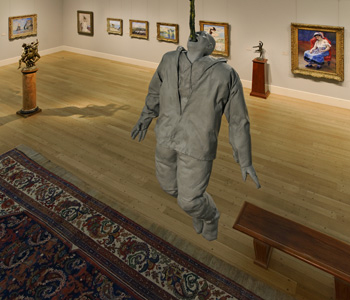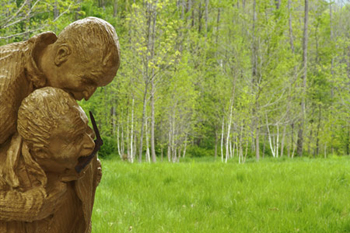
JUNE 13–october 17, 2010
About the Works
Hanging Figure
1997, resin
Private collection
Though early in his career Muñoz often used an architectural vocabulary to tell stories about people, he turned directly toward the human body in the late 1980s. This work, which references Edgar Degas’s famous painting of an acrobat, Miss Lala at the Cirque Fernando, Paris (1879), uses the ambivalence of the figure to allude to more painful, but similar, gestures such as the hanging figures in Francisco de Goya’s Disasters of War series.
Located in Gallery 2, Museum Building
© Estate of Juan Muñoz
Seated Figures with Five Drums
1999, resin
Private collection
The drum is an important motif for Muñoz because it demonstrates the possibility to make new rhythms as an affirmation, renegotiation, or denial of what has been inherited. Interested in how we receive information from our senses, the artist has his “blinded” figures using drums for means other than noise. In this artistic gesture, Muñoz asks how we come to know the world around us.
Located in Gallery 5, Museum Building
© Estate of Juan Muñoz
Piggyback with Knife
2001, bronze with yellow patina
Courtesy Marian Goodman Gallery, New York
One of Muñoz’s last sculptures, this bronze with yellow patina shows his continued interest in the human figure and enigmatic relationships as it references inherent, yet unrealized, dangers like the very early First Banister inside does.
Spencer Terrace, Stone Hill Center
© Estate of Juan Muñoz
First Banister
1987
Wood and knife
Private collection
One of his earliest works, the banister with knife attached takes an architectural object we know and undermines the safety and assurance it has come to connote. In this confrontation with expectation, the object asks for awareness and signals the danger that comes with blind acceptance of the status quo.
Stone Hill Center
© Estate of Juan Muñoz
Hotel Declercq II
1987–2000, iron
Private collection
Another early piece, the small balcony removed from context and place transforms its adopted wall into a metaphor for imagination and how our minds can conjure new worlds from white space and possibility.
Stone Hill Center
© Estate of Juan Muñoz
Many Times
1999, resin
Private collection
Similarly dressed and all modeled on an Art Nouveau ceramic bust of a head with Asian features that Muñoz discovered in a hotel, the figures in Many Times activate the physical space we share while raising ideas of otherness, the power of crowds, and isolation.
Lipp Gallery, Stone Hill Center
© Estate of Juan Muñoz
Derailment
2000–2001, corten steel
Private collection
Like such early works as First Banister and Hotel Declercq II, Muñoz’s derailed steel train (a nod to Richard Serra) implies human presence through its noticeable absence. It also questions if the built world is as fragile as the individual who could be a passenger in the train, or one who might live in the abandoned cityscape shaped in miniature inside the train cars.
Clark Gallery, Stone Hill Center
© Estate of Juan Muñoz
Conversation Piece
2001, bronze and steel cable
Private collection
One could almost see this installation, in its dramatic composition, as a reworking of Auguste Rodin’s Burghers of Calais (1895). But unlike the Rodin sculpture or any sculptural arrangement that depicts historical figures, we do not know who or what goads Muñoz’s drama into visceral action. Each viewer is invited to participate and bring his or her own experiences to this work’s ongoing conversation.
Moltz Terrace, Stone Hill Center
© Estate of Juan Muñoz

Juan Muñoz at the Clark
Introduction by Carmen Giménez
Essay by David Breslin
Photographs by Michael Agee
The enigmatic sculptures of the Spanish artist Juan Muñoz (1953–2001) invoke a mode of storytelling that speaks to memory and displacement. His works create immersive settings where the viewer is both attuned to the immediate time and context and imagines the architectures and landscapes from which the works might have been expelled. In the unique parklike setting of the Clark, notions of interiority and exteriority, of perception and absorption, are further enhanced. Works installed within traditional museum galleries, as well as in the contemplative spaces of Stone Hill Center and its adjacent terraces, invite dialogues not only with the viewer but also with the surrounding landscape and collections, challenging assumptions of beauty and pleasure, expectation and surprise.
48 pages, 9 1/4 x 9 inches
32 color illustrations
2010
Published by the Sterling and Francine Clark Art Institute
ISBN 978-0-300-16983-6








